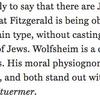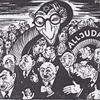3: Essay excerpt, “F. Scott Fitzgerald and Literary Anti-Semitism: A Footnote on the Mind of the 20’s,” 1947, and image, “Brood of Serpents,” 1934.
There is a long history of anti-Semitic caricatures involving Jews having large noses and grotesque physical features. Critic Milton Hindus argued that Meyer Wolfsheim was a robust example of this genre of anti-Semitism.
Suggested Activities: Have students find physical descriptions of Meyer Wolfsheim throughout The Great Gatsby. Using these descriptions, have students draw their own versions of Meyer Wolfsheim, staying as faithful as possible to the text. Have them share their images and compare and discuss what they came up with.
Then, discuss and analyze the Hindus quote. What is Hindus saying about Wolfsheim as a character? What does it mean that Wolfsheim is “without any compensations”? What does he mean by “moral physiognomy” and what does he mean by “isolation”?
With the Hindus quote in mind, have students look at the propaganda image published in Der Stuermer, a German tabloid that was popular with the Nazi Party. This tabloid was known for pushing virulently anti-Semitic ideas, images, and stories, and as early as 1933, the tabloid called for the extermination of the Jewish people. What is going on in this image? What kind of messages does this image convey to the viewer? In what ways does the image remind students of Fitzgerald’s description of Meyer Wolfsheim?
Have students compare their hand-drawn versions of Meyer Wolfsheim to the propaganda image from Der Stuermer. Do students notice any similarities between their drawing and the propaganda piece? Do the images they produced look like anti-Semitic caricatures? Why or why not?
Finally, for a more in-depth discussion, return to the Milton Hindus quote and ask students to discern the meaning of the very first sentence of the quote. Help them understand Hindus’s rejection of would-be Fitzgerald defenders who say that the author was objectively portraying a certain type of person that actually exists in the world, and therefore it’s ok. Ask students: Do you agree with this part of Hindus’s argument? If a stereotypical and negative portrayal of a Jew is based on a real person, is it still anti-Semitic? If so, is there any way for an author to write about deeply flawed Jewish characters without being anti-Semitic? What would that look like?
Sources: Milton Hindus, “F. Scott Fitzgerald and Literary Anti-Semitism: A Footnote on the Mind of the 20’s,” Commentary, June 1947, accessed online at https://www.commentarymagazine.com/articles/f-scott-fitzgerald-and-literary-anti-semitisma-footnote-on-the-mind-of-the-20s/.
“Brood of Serpents,” Der Stuermer, issue 40, July 1934, accessed online https://research.calvin.edu/german-propaganda-archive/images/sturmer/ds34-40.jpg.
Brood of Serpents
 Download image (102.5 KB)
Download image (102.5 KB)


